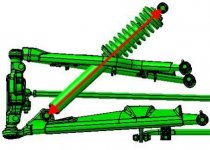I've been fighting the same thing. I believe there is not as much belly clearance on my 2013 ST-S as what I have on my 2008 GS, BUT.....the GS has adjustable preload on the front shocks, and I have them cranked to full to get the a-arms level. On the 2013 ST-S I have a BajaRon sway bar and recently installed the Fox Podium shocks. The difference in handling and reduction in wandering is awesome, but I still will scrape the center on some of the nasty little g-bumps (rounded out gullies where the weight of the machine comes down on the frame).
I do not believe it is bottoming the front suspension, should be nowhere near full travel, this is high-centering bottoming. That said, it occurs at lower shock speeds, so ideally some more low speed damping would be nice to have. Never had an issue at higher shock speeds, quicker square-edge style bumps, so the high speed damping seems to be OK. Might have to look into shocks with adjustable low speed and high speed damping (that's shock rod speed, not vehicle speed).
As for spring preload, there is a very specific specification for shock center to center distance which can not be attained with the non-adjustable preload type shocks that were stock on the 2013 ST-S, I'm not sure what the Limited had last year. The preload is supposed to be set to get this desired center (mounting bolt centers). On the 2013-2014 ST and RS models this spec is 420 mm, or 16.5 inches. (All 2008-2012 models were 428mm, or 16.85", and the 2013-2014 RT models are 445 mm, or 17.5".) So basically we are supposed to be setting the preload to get the proper ride height, as determined by this shock measurement. Ideally. Past that, we need more clearance.....
The info I have states, "
The importance of properly adjusting the shock preload is to set the vehicle at a ride height at which the vehicle was designed to operate. Alignment values are determined at precise ride height values. Ride height is also the position at which the alignment is the most stable and less influenced by bump steer.
In order to properly adjust the vehicle’s ride height, have the customer sit on the unit and add approximately what the customer loads in the front cargo bin. Measure the distance between the front shock bolt centers. Adjust the preload in order to reach the desired value in the ride height chart. Remember to lift the vehicle to adjust the shock cams or rings in order to avoid damage to these components.
Preload does not influence stiffness nor softness of the ride, it only adjusts the ride height."
View attachment 90974

